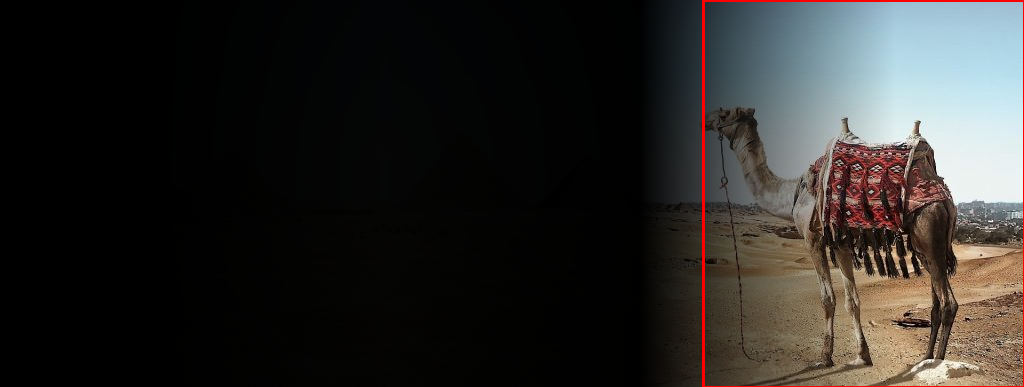【pytorch】改造resnet为全卷积神经网络以适应不同大小的输入
为什么resnet的输入是一定的?
因为resnet最后有一个全连接层。正是因为这个全连接层导致了输入的图像的大小必须是固定的。
输入为固定的大小有什么局限性?
原始的resnet在imagenet数据集上都会将图像缩放成224×224的大小,但这么做会有一些局限性:
(1)当目标对象占据图像中的位置很小时,对图像进行缩放将导致图像中的对象进一步缩小,图像可能不会正确被分类
(2)当图像不是正方形或对象不位于图像的中心处,缩放将导致图像变形
(3)如果使用滑动窗口法去寻找目标对象,这种操作是昂贵的
如何修改resnet使其适应不同大小的输入?
(1)自定义一个自己网络类,但是需要继承models.ResNet
(2)将自适应平均池化替换成普通的平均池化
(3)将全连接层替换成卷积层
相关代码:
import torch
import torch.nn as nn
from torchvision import models
import torchvision.transforms as transforms
from torch.hub import load_state_dict_from_url from PIL import Image
import cv2
import numpy as np
from matplotlib import pyplot as plt class FullyConvolutionalResnet18(models.ResNet):
def __init__(self, num_classes=1000, pretrained=False, **kwargs): # Start with standard resnet18 defined here
super().__init__(block = models.resnet.BasicBlock, layers = [2, 2, 2, 2], num_classes = num_classes, **kwargs)
if pretrained:
state_dict = load_state_dict_from_url( models.resnet.model_urls["resnet18"], progress=True)
self.load_state_dict(state_dict) # Replace AdaptiveAvgPool2d with standard AvgPool2d
self.avgpool = nn.AvgPool2d((7, 7)) # Convert the original fc layer to a convolutional layer.
self.last_conv = torch.nn.Conv2d( in_channels = self.fc.in_features, out_channels = num_classes, kernel_size = 1)
self.last_conv.weight.data.copy_( self.fc.weight.data.view ( *self.fc.weight.data.shape, 1, 1))
self.last_conv.bias.data.copy_ (self.fc.bias.data) # Reimplementing forward pass.
def _forward_impl(self, x):
# Standard forward for resnet18
x = self.conv1(x)
x = self.bn1(x)
x = self.relu(x)
x = self.maxpool(x) x = self.layer1(x)
x = self.layer2(x)
x = self.layer3(x)
x = self.layer4(x)
x = self.avgpool(x) # Notice, there is no forward pass
# through the original fully connected layer.
# Instead, we forward pass through the last conv layer
x = self.last_conv(x)
return x
需要注意的是我们将全连接层的参数拷贝到自己定义的卷积层中去了。
看一下网络结构,主要是关注网络的最后:

我们将self.avgpool替换成了AvgPool2d,而全连接层虽然还在网络中,但是在前向传播时我们并没有用到 。
现在我们有这么一张图像:

图像大小为:(387, 1024, 3)。而且目标对象骆驼是位于图像的右下角的。
我们就以这张图片看一下是怎么使用的。
with open('imagenet_classes.txt') as f:
labels = [line.strip() for line in f.readlines()]
# Read image
original_image = cv2.imread('camel.jpg')# Convert original image to RGB format
image = cv2.cvtColor(original_image, cv2.COLOR_BGR2RGB)
# Transform input image
# 1. Convert to Tensor
# 2. Subtract mean
# 3. Divide by standard deviation
transform = transforms.Compose([
transforms.ToTensor(), #Convert image to tensor.
transforms.Normalize(
mean=[0.485, 0.456, 0.406], # Subtract mean
std=[0.229, 0.224, 0.225] # Divide by standard deviation
)])
image = transform(image)
image = image.unsqueeze(0)
# Load modified resnet18 model with pretrained ImageNet weights
model = fcresnet18.FullyConvolutionalResnet18(pretrained=True).eval()
print(model)
with torch.no_grad():
# Perform inference.
# Instead of a 1x1000 vector, we will get a
# 1x1000xnxm output ( i.e. a probabibility map
# of size n x m for each 1000 class,
# where n and m depend on the size of the image.)
preds = model(image)
preds = torch.softmax(preds, dim=1)
print('Response map shape : ', preds.shape)
# Find the class with the maximum score in the n x m output map
pred, class_idx = torch.max(preds, dim=1)
print(class_idx)
row_max, row_idx = torch.max(pred, dim=1)
col_max, col_idx = torch.max(row_max, dim=1)
predicted_class = class_idx[0, row_idx[0, col_idx], col_idx]
# Print top predicted class
print('Predicted Class : ', labels[predicted_class], predicted_class)
说明:imagenet_classes.txt中是标签信息。在数据增强时,并没有将图像重新调整大小。用opencv读取的图片的格式为BGR,我们需要将其转换为pytorch的格式:RGB。同时需要使用unsqueeze(0)增加一个维度,变成[batchsize,channel,height,width]。看一下avgpool和last_conv的输出的维度:
我们使用torchsummary库来进行每一层输出的查看:
device = torch.device("cuda" if torch.cuda.is_available() else "cpu")
model.to(device)
from torchsummary import summary
summary(model, (3, 387, 1024))
结果:
----------------------------------------------------------------
Layer (type) Output Shape Param #
================================================================
Conv2d-1 [-1, 64, 194, 512] 9,408
BatchNorm2d-2 [-1, 64, 194, 512] 128
ReLU-3 [-1, 64, 194, 512] 0
MaxPool2d-4 [-1, 64, 97, 256] 0
Conv2d-5 [-1, 64, 97, 256] 36,864
BatchNorm2d-6 [-1, 64, 97, 256] 128
ReLU-7 [-1, 64, 97, 256] 0
Conv2d-8 [-1, 64, 97, 256] 36,864
BatchNorm2d-9 [-1, 64, 97, 256] 128
ReLU-10 [-1, 64, 97, 256] 0
BasicBlock-11 [-1, 64, 97, 256] 0
Conv2d-12 [-1, 64, 97, 256] 36,864
BatchNorm2d-13 [-1, 64, 97, 256] 128
ReLU-14 [-1, 64, 97, 256] 0
Conv2d-15 [-1, 64, 97, 256] 36,864
BatchNorm2d-16 [-1, 64, 97, 256] 128
ReLU-17 [-1, 64, 97, 256] 0
BasicBlock-18 [-1, 64, 97, 256] 0
Conv2d-19 [-1, 128, 49, 128] 73,728
BatchNorm2d-20 [-1, 128, 49, 128] 256
ReLU-21 [-1, 128, 49, 128] 0
Conv2d-22 [-1, 128, 49, 128] 147,456
BatchNorm2d-23 [-1, 128, 49, 128] 256
Conv2d-24 [-1, 128, 49, 128] 8,192
BatchNorm2d-25 [-1, 128, 49, 128] 256
ReLU-26 [-1, 128, 49, 128] 0
BasicBlock-27 [-1, 128, 49, 128] 0
Conv2d-28 [-1, 128, 49, 128] 147,456
BatchNorm2d-29 [-1, 128, 49, 128] 256
ReLU-30 [-1, 128, 49, 128] 0
Conv2d-31 [-1, 128, 49, 128] 147,456
BatchNorm2d-32 [-1, 128, 49, 128] 256
ReLU-33 [-1, 128, 49, 128] 0
BasicBlock-34 [-1, 128, 49, 128] 0
Conv2d-35 [-1, 256, 25, 64] 294,912
BatchNorm2d-36 [-1, 256, 25, 64] 512
ReLU-37 [-1, 256, 25, 64] 0
Conv2d-38 [-1, 256, 25, 64] 589,824
BatchNorm2d-39 [-1, 256, 25, 64] 512
Conv2d-40 [-1, 256, 25, 64] 32,768
BatchNorm2d-41 [-1, 256, 25, 64] 512
ReLU-42 [-1, 256, 25, 64] 0
BasicBlock-43 [-1, 256, 25, 64] 0
Conv2d-44 [-1, 256, 25, 64] 589,824
BatchNorm2d-45 [-1, 256, 25, 64] 512
ReLU-46 [-1, 256, 25, 64] 0
Conv2d-47 [-1, 256, 25, 64] 589,824
BatchNorm2d-48 [-1, 256, 25, 64] 512
ReLU-49 [-1, 256, 25, 64] 0
BasicBlock-50 [-1, 256, 25, 64] 0
Conv2d-51 [-1, 512, 13, 32] 1,179,648
BatchNorm2d-52 [-1, 512, 13, 32] 1,024
ReLU-53 [-1, 512, 13, 32] 0
Conv2d-54 [-1, 512, 13, 32] 2,359,296
BatchNorm2d-55 [-1, 512, 13, 32] 1,024
Conv2d-56 [-1, 512, 13, 32] 131,072
BatchNorm2d-57 [-1, 512, 13, 32] 1,024
ReLU-58 [-1, 512, 13, 32] 0
BasicBlock-59 [-1, 512, 13, 32] 0
Conv2d-60 [-1, 512, 13, 32] 2,359,296
BatchNorm2d-61 [-1, 512, 13, 32] 1,024
ReLU-62 [-1, 512, 13, 32] 0
Conv2d-63 [-1, 512, 13, 32] 2,359,296
BatchNorm2d-64 [-1, 512, 13, 32] 1,024
ReLU-65 [-1, 512, 13, 32] 0
BasicBlock-66 [-1, 512, 13, 32] 0
AvgPool2d-67 [-1, 512, 1, 4] 0
Conv2d-68 [-1, 1000, 1, 4] 513,000
================================================================
Total params: 11,689,512
Trainable params: 11,689,512
Non-trainable params: 0
----------------------------------------------------------------
Input size (MB): 4.54
Forward/backward pass size (MB): 501.42
Params size (MB): 44.59
Estimated Total Size (MB): 550.55
----------------------------------------------------------------
最后是看一下预测的结果:
Response map shape : torch.Size([1, 1000, 1, 4])
tensor([[[978, 980, 970, 354]]])
Predicted Class : Arabian camel, dromedary, Camelus dromedarius tensor([354])
与imagenet_classes.txt中对应(索引下标是从0开始的)

可视化关注点:
from google.colab.patches import cv2_imshow
# Find the n x m score map for the predicted class
score_map = preds[0, predicted_class, :, :].cpu().numpy()
score_map = score_map[0] # Resize score map to the original image size
score_map = cv2.resize(score_map, (original_image.shape[1], original_image.shape[0])) # Binarize score map
_, score_map_for_contours = cv2.threshold(score_map, 0.25, 1, type=cv2.THRESH_BINARY)
score_map_for_contours = score_map_for_contours.astype(np.uint8).copy() # Find the countour of the binary blob
contours, _ = cv2.findContours(score_map_for_contours, mode=cv2.RETR_EXTERNAL, method=cv2.CHAIN_APPROX_SIMPLE) # Find bounding box around the object.
rect = cv2.boundingRect(contours[0])
# Apply score map as a mask to original image
score_map = score_map - np.min(score_map[:])
score_map = score_map / np.max(score_map[:])
score_map = cv2.cvtColor(score_map, cv2.COLOR_GRAY2BGR)
masked_image = (original_image * score_map).astype(np.uint8) # Display bounding box
cv2.rectangle(masked_image, rect[:2], (rect[0] + rect[2], rect[1] + rect[3]), (0, 0, 255), 2) # Display images
#cv2.imshow("Original Image", original_image)
#cv2.imshow("activations_and_bbox", masked_image)
cv2_imshow(original_image)
cv2_imshow(masked_image)
cv2.waitKey(0)
在谷歌colab中ipynb要使用:from google.colab.patches import cv2_imshow

参考:https://www.learnopencv.com/cnn-receptive-field-computation-using-backprop/?ck_subscriber_id=503149816
【pytorch】改造resnet为全卷积神经网络以适应不同大小的输入的更多相关文章
- 全卷积神经网络FCN详解(附带Tensorflow详解代码实现)
一.导论 在图像语义分割领域,困扰了计算机科学家很多年的一个问题则是我们如何才能将我们感兴趣的对象和不感兴趣的对象分别分割开来呢?比如我们有一只小猫的图片,怎样才能够通过计算机自己对图像进行识别达到将 ...
- 全卷积神经网络FCN
卷积神经网络CNN(YannLecun,1998年)通过构建多层的卷积层自动提取图像上的特征,一般来说,排在前边较浅的卷积层采用较小的感知域,可以学习到图像的一些局部的特征(如纹理特征),排在后边较深 ...
- 全卷积神经网络FCN理解
论文地址:https://people.eecs.berkeley.edu/~jonlong/long_shelhamer_fcn.pdf 这篇论文使用全卷积神经网络来做语义上的图像分割,开创了这一领 ...
- pytorch实战(7)-----卷积神经网络
一.卷积: 卷积在 pytorch 中有两种方式: [实际使用中基本都使用 nn.Conv2d() 这种形式] 一种是 torch.nn.Conv2d(), 一种是 torch.nn.function ...
- Pytorch修改ResNet模型全连接层进行直接训练
之前在用预训练的ResNet的模型进行迁移训练时,是固定除最后一层的前面层权重,然后把全连接层输出改为自己需要的数目,进行最后一层的训练,那么现在假如想要只是把 最后一层的输出改一下,不需要加载前面层 ...
- 基于区域的全卷积神经网络(R-FCN)简介
在 Faster R-CNN 中,检测器使用了多个全连接层进行预测.如果有 2000 个 ROI,那么成本非常高. feature_maps = process(image)ROIs = region ...
- 卷积神经网络概念及使用 PyTorch 简单实现
卷积神经网络 卷积神经网络(CNN)是深度学习的代表算法之一 .具有表征学习能力,能够按其阶层结构对输入信息进行平移不变分类,因此也被称为“平移不变人工神经网络”.随着深度学习理论的提出和数值计算设备 ...
- 手写数字识别 卷积神经网络 Pytorch框架实现
MNIST 手写数字识别 卷积神经网络 Pytorch框架 谨此纪念刚入门的我在卷积神经网络上面的摸爬滚打 说明 下面代码是使用pytorch来实现的LeNet,可以正常运行测试,自己添加了一些注释, ...
- PyTorch基础——使用卷积神经网络识别手写数字
一.介绍 实验内容 内容包括用 PyTorch 来实现一个卷积神经网络,从而实现手写数字识别任务. 除此之外,还对卷积神经网络的卷积核.特征图等进行了分析,引出了过滤器的概念,并简单示了卷积神经网络的 ...
随机推荐
- CSRF之POST
最近重温<白帽子讲web安全>一书,看到第4章CSRF的时候,发现有个错误的地方,第116页底部的代码中有个坑,那段代码是运行不了的.原因是在form表单中有个<input type ...
- python3.4多线程实现同步的四种方式
临界资源即那些一次只能被一个线程访问的资源,典型例子就是打印机,它一次只能被一个程序用来执行打印功能,因为不能多个线程同时操作,而访问这部分资源的代码通常称之为临界区. 1. 锁机制 threadin ...
- GIT 使用(二):创建仓库并提交代码
基本操作 所用命令使用 windows 下安装 git-bash 运行 Table of Contents 先决条件 已经安装了 GIT 客户端 已经设置用户信息 如果没做可以看安装和配置 获取 Gi ...
- Samtec与Neoconix达成合作并和II-VI推出新产品
序言:Samtec近日动作不断, 近日Samtec与Neoconix达成合作并和II-VI推出新产品,以下是详细内容. Samtec与Neoconix签订Neoconix PCBeam 技术授权协议, ...
- 【CSS3】自定义设置可编辑元素闪烁光标的颜色
前言 因为业务需求, 要求我们的input框内的文本与悬浮的光标颜色不同, 这样的问题肯定在书本上很难找到解决办法, 需要通过平时的基础积累和经验. 解决方案 使用 ::first-line 伪元素 ...
- mupdf 基于命令行的 pdf转图片
下载地址: https://www.mupdf.com/downloads/index.html 使用方法: 打开cmd,切换到mupdf文件路径下,再在命令行中敲入命令 mutool.exe d ...
- hadoop之完全分布式集群配置(centos7)
一.基础环境 现在我们有两台虚拟机了,再克隆两台: 克隆好之后需要做三件事:1.更改主机名称 2.修改ip地址 3.将ip地址和对应的主机号加入到/etc/hosts文件中 1.永久修改主机名 hos ...
- python 深浅拷贝 元组 字典 集合操作
深浅拷贝 :值拷贝 :ls = [,,] res = ls 则print(res)就是[,,] 浅拷贝 :ls.copy() 深拷贝:ls3 = deepcopy(ls) # 新开辟列表空间,ls列表 ...
- php+apache 环境配置(window环境)
最近,小主从事PHP开发.特将最近如何搭建php7的过程记录在此!希望有需要,可以借鉴!( 电脑必须win7 sp1以上, .netframework4 ) Windows7安装php7,Win7+p ...
- 如何为SpringBoot服务添加HTTPS证书
HTTPS是HTTP的安全版本,旨在提供数据传输层安全性(TLS).当你的应用不使用HTTP协议的时候,浏览器地址栏就会出现一个不安全的提示.HTTPS加密每个数据包以安全方式进行传输,并保护敏感数据 ...
